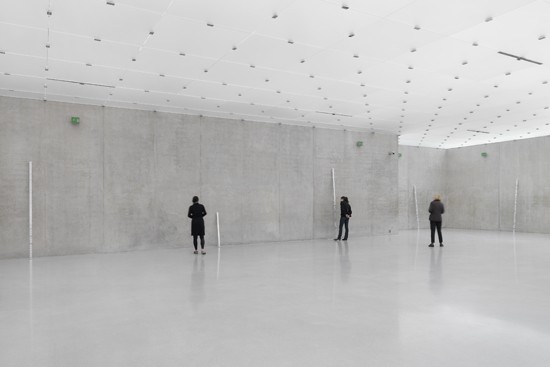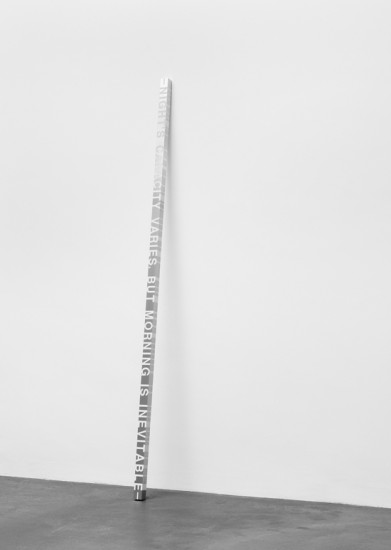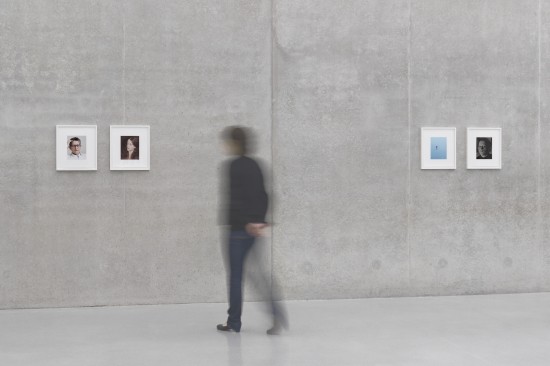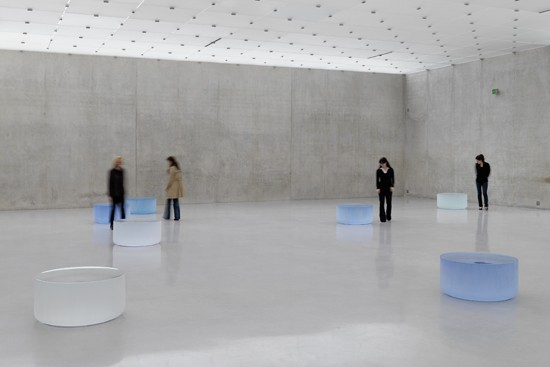Who I am or what I do
By Aveek Sen
 Installation view, 1st floor, of “Roni Horn: Well and Truly” at Kunsthaus Bregenz, 2010. Photo Stefan Altenburger, © Kunsthaus Bregenz, Roni Horn.
Installation view, 1st floor, of “Roni Horn: Well and Truly” at Kunsthaus Bregenz, 2010. Photo Stefan Altenburger, © Kunsthaus Bregenz, Roni Horn.On an “unspeakably quiet” summer afternoon in August 1870, the literary critic Thomas Wentworth Higginson found himself on a curious visit to the country town of Amherst, Massachusetts. He was calling on a 40-year-old single woman living with her parents and siblings in their family homestead. Emily Dickinson and Higginson had been correspondents for a few years, she sending him her little poems for critical advice. This was the first time they had arranged to meet at Emily’s home, and Higginson was apprehensive. The chiselled emotion of Emily’s writing had often made him uncomfortable as a correspondent. As he waited in the “dark & cool & stiffish” parlor, her arrival was heralded by a step “like a pattering child’s.” Emily entered, “a little plain woman,” and presented her visitor with two daylilies, which she put, “in a sort of childlike way,” into his hand and then said, “These are my introduction.” Higginson wrote to his wife, on the same day, of Emily’s “soft frightened breathless childlike voice”:
[She] added under her breath Forgive me if I am frightened; I never see strangers & hardly know what I say – but she talked soon & thenceforward continuously – & deferentially – sometimes stopping to ask me to talk instead of her – but readily recommencing.
Higginson met Emily twice on that visit, and his journal letter to his wife tried to record the manner and content of Emily’s “thoroughly ingenuous and simple” talk. The flow of their conversation touched on Emily’s father, who read “lonely & rigorous books” only on Sundays, her baking bread for him and her coming upon Shakespeare and wondering why any other book was needed. “If I read a book [and] it makes my whole body so cold no fire ever can warm me I know that is poetry,” she told him. “How do most people live without any thoughts?” she asked him, “How do they get strength to put on their clothes in the morning?” Then, “Could you tell me what home is?” She asked him about memory and forgetting: “Is it oblivion or absorption when things pass from our minds?” Finally, she said to him at parting, “Gratitude is the only secret that cannot reveal itself.” Higginson confessed to his wife that he had never been with anyone who drained his “nerve power” so much. Twenty years later, and five years after Emily’s death, he reminisced about this visit to the readers of the Atlantic Monthly from a more comfortable distance: “She was much too enigmatical a being to solve in an hour’s interview…I could only sit still and watch, as one does in the woods; I must name my bird without a gun, as recommended by Emerson.”
Is it oblivion or absorption when things pass from our minds? Emily Dickinson’s startling question reached me for the first time, not through Higginson’s account, but in white, solid-cast plastic letters laid into a tall, slim aluminum bar resting against a wall in Austria. This was one of 14 bars of varying heights, each inlaid with an utterance by the poet culled from her letters, poems copied into letters and recorded conversation. These bars form a body of work called “White Dickinson” made by the artist Roni Horn in 2007. Set on the first floor of the Kunsthaus Bregenz, “White Dickinson” is part of “Well and Truly,” an exhibition of Horn’s drawings, sculptures and photographic works, installed with precision and spareness in the four floors of the Kunsthaus.
 White Dickinson: NIGHT’S CAPACITY VARIES, BUT MORNING IS
White Dickinson: NIGHT’S CAPACITY VARIES, BUT MORNING ISINEVITABLE (2007), Aluminum and white plastic, 250 x 5 x 5 cm.
Courtesy the artist and Hauser & Wirth.
Returning to Calcutta, where I live, I began looking up the “White Dickinson” sentences in Emily’s collected letters. As each sentence I had encountered in Bregenz quietly stood out from the surrounding text, an elusive feeling of déjà vu, of recognition, resonance and repetition, of division, doubling and vicariousness, began to inform my experience of reading the letters. Emily and Roni, voice and text, reading and looking, reading and remembering, writing and sculpture, identity and difference – these became the dyads into which the distinct activities of reading Dickinson and viewing Horn started splitting and merging at once. This produced a visual, emotional and intellectual experience of the sharpest singularity.
As I read Higginson’s account, for instance, I was acutely aware not only of Horn reading it too and picking up that particular question, but also of her visiting the same house in Amherst and photographing the views from the poet’s bedroom, inaccessible to Higginson, for her series, “From the Windows of Emily Dickinson’s Bedroom” (1994-95). So, behind my encounter with Emily’s words in Bregenz, and then in Calcutta, lay Horn’s encounter with them in her beloved Iceland (where she had first read the poems in solitude), her subsequent visit to Amherst to shoot from Emily’s windows and, finally, Higginson’s actual encounter with the poet and her talk. These different, but converging, encounters doubled and re-doubled the identity of the words, thing or person encountered; they made the acts of reading, viewing and placing endlessly plural. Yet, more than the several major bodies of work that Horn has made out of Dickinson’s poetry, “White Dickinson” has a voice, or a silence, uniquely its own – a particularity that survives the dissolution of a single authorial or spectatorial identity.
At the Kunsthaus, compelled to remain on my feet by the absence of seating in the room, and surrounded by the coded stillness of the aluminum bars, it was impossible not to sense their totem-like singleness of presence. They were like sentinels guarding the borders of a clearing. But they seemed to have given up their uprightness to lean against that which they knew to be larger and harder than what they were. In this, they were both less and more than their kin, Louise Bourgeois’ “Personages,” who started out by leaning against the studio wall, but stand perfectly upright on their pedestals as public figures.
At the heart of “White Dickinson,” then, is a clearing in which the viewer moves or stands. It is an empty but living space created by multiple conversations turning into vanishing acts. In this space, the viewer begins to play a “This is me, this is you” game with the work, only to realize that, within the work, the sculptor and the poet are playing a similar game with each other. For these two artists of the articulated word, to keep at this game – with each other, with the viewer – is a way of keeping reticence, remoteness and mystery at the core of their art.
 Installation view of a.k.a. (2008/09) at Kunsthaus Bregenz. Ink jet prints on rag paper, 30 paired photographs, each 38.1 x 33 cm. Photo Stefan Altenburger, © Kunsthaus Bregenz, Roni Horn.
Installation view of a.k.a. (2008/09) at Kunsthaus Bregenz. Ink jet prints on rag paper, 30 paired photographs, each 38.1 x 33 cm. Photo Stefan Altenburger, © Kunsthaus Bregenz, Roni Horn.Directly above this floor, in an identical room, was another clearing (this time with seats) surrounded by another strictly ordered set of presences against the walls. The rules of the game were different here, and the vanishing trick stood on its head: we get to see nothing but the artist. In a.k.a. (2008/09), 15 pairs of portraits of Roni Horn in color and black-and-white from her childhood to the present are framed in white and hung with an austere uniformity at eye-level. We are not told who made these photographs, or whether some were self-portraits, and each pair straddles abysses of time and visual difference. This is a typology of the self in and out of time, in which fleeting marks of identity (a smile, a pout, a certain angle of the head or an occasional tiredness around the eyes) afford moments of recognition and continuity in a sequence that wilfully courts discontinuity and dissimilarity. In bringing these photographs together, Horn silently appropriates the perceptions of others to make a work that becomes her own. The apparent unity of her subject, together with the symmetry and repetitiveness of the hanging, becomes the grid within which the disorderly transformations of the self are played with and held.
In being both palimpsest and palindrome, a.k.a. is, and is not, a sequence. Each paired unit of the sequence traps the viewer in a time-shuttle that thwarts all attempts at moving chronologically or linearly through the sequence. This compels the viewer to look at, and think about, human change as a process of self-making driven not only by diachronic time but also by other synchronic aspects of personhood. Yet, Horn’s work with photographic portraits, whatever her subject (birds, women, places, rivers or herself), halts our pursuit of the inscrutable and elusive at the façades of the visible, which often turn out to be the mystery or eroticism of simply a face (or face-like form).
Up another identical flight of stairs into an identical room – but everything seemed to change here into an always-new, blue-and-white world of daylight, glass and utter transparency. It felt like an ascent from art into nature, or from literature to music, but deceptively so. Installed on the third floor, the eponymous Well and Truly (2009/10) is artifice – casting, cooling and polishing – at its most consummate. Perfection almost effaces process. In this work, Horn places, without any obvious order, 10 identically shaped low, round, solid-cast glass objects in finely modulated shades of pale blue, blue-green, gray and white on the dark-gray terrazzo floor. They are lit by diffuse daylight, which keeps changing with time. Horn’s glass pieces occupy what had been the central clearing on the other floors. As such, they seem to mingle with the viewers in what had begun to feel like the viewers’ space. Viewers have to meander around the pieces, and the best view of all of them together is from the margins of the room, where, in the floors below, the artworks were installed, thus reversing the placing of the viewer in relation to the work. We are allowed to look into the pieces from above and ponder their peculiarly liquid solidness, to gaze at the absolute clarity of the glass, which reveals yet denies access to its own depths. As we contemplate these objects, they seem to lose their materiality and become pure light, or even pure sound – clear bell-tones whose fine shifts in volume and pitch are marked by subtle changes in color and texture. Perhaps what we are brought close to here, at architecturally the highest level of the show, is pure presence, or rather the effect of pure presence, in which human form, language and meaning, together with the differences between heavy and light, solid and liquid, clear and opaque, empty and full, depth and surface, evaporate or get absorbed into, first, the physical, and then the metaphysical essence of the material out of which that presence is forged – in this case, glass.
 Installation view of Well and Truly (2009/10) at Kunsthaus Bregenz. Solid cast blue glass, 10 parts, each: 91.5 cm diameter, 45.5 cm high. Photo Stefan Altenburger, © Kunsthaus Bregenz, Roni Horn.
Installation view of Well and Truly (2009/10) at Kunsthaus Bregenz. Solid cast blue glass, 10 parts, each: 91.5 cm diameter, 45.5 cm high. Photo Stefan Altenburger, © Kunsthaus Bregenz, Roni Horn.Yet, “one would want more, one would need more” than this perfectly polished glass, in the words of Wallace Stevens, whose poetry Horn knows well. Faced with such a “world of clear water, brilliant-edged,” around which the “day itself is simplified,” this need for something more difficult and complicated wells up as a conviction in Stevens’ “The Poem of our Climate”:
There would still remain the never-resting mind,
So that one would want to escape, come back
To what had been so long composed.
The imperfect is our paradise.
To return to the imperfected work of never-resting thought, I had to go all the way down the gray stairs, past the photographs and the aluminum bars, to the ground floor, where all the ladders start. The exhibition begins here with three large pigment-and-varnish drawings on paper, cryptically titled Enough 8 (2004), Enough 10 (2005) and Through 6 (2007).
Somewhere between portraiture and cartography, each of these pigment drawings in red or blue on white paper (and sometimes paired) is like an immense, shattered labyrinth. Studying them up close, one gets lost or trapped in what could be a giant face, a precariously assembled presence, falling apart like shivered glass, yet somehow managing to hold itself together, or the aerial view of a piece of land or island (Iceland?) as it begins to scatter or implode with the impact of some internal tectonic disturbance. Made by cutting apart and then painstakingly putting back together over months “plates” that had complete drawings done on them before they were cut up, these complex and precise assemblages scrupulously display the marks of their making, unmaking and remaking. There are sharp cuts and joins in the paper, its whiteness smudged and soiled with red or blue fingerprints, apart from pinholes and strange “registration marks,” ensuring continuity over time, such as repeated little lines, numbers, letters or single, Beckettian words like blood, crap and top, or rhyming ones like crow, low, snow, joe and toe. They are like the “flawed words and stubborn sounds” that make up the imperfect in Stevens’ poem, the “compounded, vital I.” Horn’s pigment drawings pull the viewer close, as they did the artist and writer Tacita Dean, who found herself trying to follow the curving lines of the cut-up plates “interrupting themselves on the way to new form.” But the drawings also push the viewer away, for it is only distance that restores coherence to these alluring “new forms.”
Through and Enough – Horn’s titles hint at an ongoing process, a working through, while they also impose arbitrary closures: This is enough, I’m through. Well and Truly also implies a sort of suspended decisiveness, which counters Horn’s preoccupation with fluidity, contradiction and paradox. In the “Subject Index” of the two-volume publication Roni Horn aka Roni Horn (2009), there is an entry under “enough,” written by the artist herself, which makes “enoughness” a deeply desired state of simply being somewhere without having to read, write or leave any mark of presence on the place. Yet, this enoughness is not something given, but has to be invented continually and guarded from the meddlings of “the never-resting mind.” To be somewhere, but to know the place as it used to exist before one’s arrival; to think without being caught in the structures of one’s thought. These impossible and contradictory desires, so lucidly and variously materialized at Kunsthaus Bregenz, are perhaps inevitable in someone who not only talks about herself as an encyclopedist of identity, but also sees that encyclopedia as being compiled by an “escape artist”: “Something about me really forces me to camouflage myself against the potential that someone will ever know who I am or what I do.”
“Roni Horn: Well and Truly” continues at Kunsthaus Bregenz through July 4, 2010.
Aveek Sen is senior assistant editor (editorial pages) of The Telegraph, Calcutta. He studied English literature at Jadavpur University, Calcutta, and University College, Oxford, and taught English literature at St Hilda’s College, Oxford. He was awarded the 2009 Infinity Award for writing on photography by the International Center of Photography, New York.
